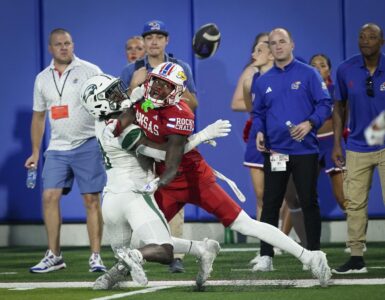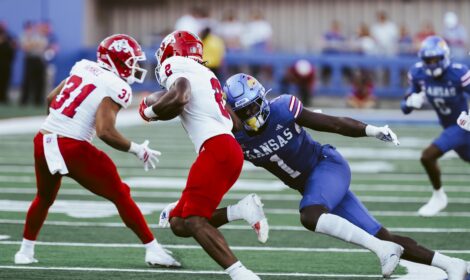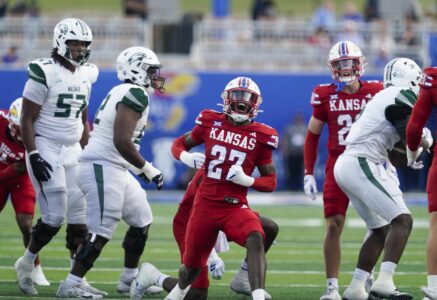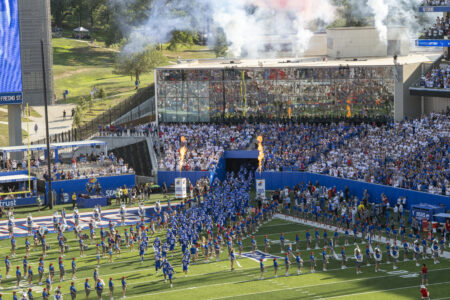Projecting roles for KU’s spring transfer additions

photo by: AP Photo/Adrian Kraus
Syracuse offensive lineman Enrique Cruz Jr. (70) blocks during the second half of an NCAA college football game against Army in Syracuse, N.Y., Saturday, Sept. 23, 2023.
What looked like a relatively tidy spring transfer window for Kansas got a bit messier when tight end Keyan Burnett, just a few months removed from deciding to transfer to KU from Arizona, opted to head back into the portal. On Sunday, Burnett decided to return to Arizona, according to multiple reports.
That unexpected flip creates one big hole for KU entering the month of May at a position that does not feature a lot of experience. Even seventh-year senior DeShawn Hanika, now the presumptive starter, hasn’t taken the field for a game since 2022.
Otherwise, though, the Jayhawks addressed each of their salient needs with quick and purposeful additions in the spring portal, all of whom will likely figure into a rotation of some kind in 2025.
Here’s a closer look at some reasonable expectations for the players they have acquired thus far, and at how a forthcoming tight end could slot in behind Hanika.

photo by: Jenny Butler/Illinois Athletics
Illinois defensive end Alex Bray takes on the Kansas offensive line on Saturday, Sept. 7, 2024, in Champaign, Ill.
Alex Bray
Predicted role: No. 2 strong-side defensive end
Last year’s player in this role: Dylan Wudke, 306 defensive snaps (26 per game)
Explanation: Justice Finkley will be firmly ensconced as the starter at strong-side defensive end after having spent the spring with the Jayhawks. He has the experience from his Texas tenure to rise to the level of Big 12 competition, the demeanor and work ethic to lead by example on one of KU’s best units and the body type at 6-foot-2, 250 pounds, to stop the run.
Bray is only a year younger and 81 cumulative snaps less experienced than Finkley after a busy second season at Illinois, but like the rest of these transfers he’ll be at an inherent disadvantage joining KU for the first time during the summer.
However, because KU rotates so thoroughly on the defensive line, there will be no shortage of situational applications for Bray’s skill set. The native of Chesterfield, Missouri, is even bigger at 6-foot-4, 270 pounds, meaning he could provide greater size in goal-line situations or shift inside for a somewhat better pass rush on third-and-long.
Dakyus Brinkley is probably better suited to play on the weak side with Bray in and Bai Jobe out, and Dylan Brooks (coming off a season-long injury) and true freshman Adrian Holley are the primary other options on the strong side. That means Bray could be in line for an even greater role than Wudke, who was pretty effective in his lone year with the Jayhawks.

photo by: AP Photo/Phelan M. Ebenhack
Florida State defensive lineman Jared Verse (5) works against Syracuse offensive lineman Enrique Cruz Jr. (70) during the first half of an NCAA college football game, Saturday, Oct. 14, 2023, in Tallahassee, Fla.
Enrique Cruz Jr.
Predicted role: Starting right tackle
Last year’s player in this role: Logan Brown, 619 offensive snaps (56 per game)
Explanation: Nolan Gorczyca has been a great example of incremental growth during his tenure at KU, but it might be a bit much to ask for the Jayhawks to have him serve as the primary right tackle in his fifth-year senior season. The final Buffalo transfer left at KU four years after Lance Leipold’s arrival, Gorczyca was one of the standout players of the spring of 2024 but then played only 43 offensive snaps during the following year as Calvin Clements took his place in the pecking order.
With Brown and Bryce Cabeldue gone to the NFL, Gorczyca began this past spring as the top choice at right tackle, but suffered a hand injury that required finger surgery and kept him out for the second half of the spring. Leipold told reporters that he is not sure when Gorczyca will be cleared to return to action during the summer.
Cruz, although he was reduced to a tiny role in his final year at Syracuse, has experience as a season-long starter for the Orange in 2023, when he started every game at left tackle. He didn’t grade out especially well but played some of his best football toward the end of that year and didn’t allow a sack all season.
He’ll need to slot in on the right side with Clements installed as KU’s left tackle of the present and future, and this will be a position battle to watch between Cruz and Gorczyca, but the Jayhawks will likely be better suited and Jalon Daniels will be better protected if Cruz seizes the starting role and Gorczyca serves as a swing tackle.

photo by: Georgia Tech Athletics/Danny Karnik
Georgia Tech cornerback Syeed Gibbs defends during a game against Duke on Saturday, Oct. 5, 2024, in Atlanta.
Syeed Gibbs
Predicted role: Nickel corner
Last year’s player in this role: Jalen Todd, 93 of his 150 defensive snaps at slot corner (13 per game)
Explanation: It’s not easy to say definitively who played nickel for KU last year because the Jayhawks employed an early-season arrangement in which Damarius McGhee (no longer on the roster) came in on the outside and Cobee Bryant moved inside, before Todd saw more time in the slot later in his freshman year.
It may not be easy to say exactly what the nickel role looks like in 2025, either, not only because of new player personnel but also because first-year defensive coordinator D.K. McDonald is keeping his schematic cards close to the vest. There were some suggestions from players over the course of the spring that KU could run more of a 4-2-5 than its past 4-3, meaning the role for a fifth defensive back — someone like Gibbs — could be significantly expanded.
Now, Gibbs played outside corner in his well-regarded 2023 season at Rhode Island, before he moved up to the FBS level and spent most of 2024 in the slot at Georgia Tech. KU’s coaching staff tends to appreciate versatility and it wouldn’t be a surprise to see the Massachusetts native spend time in both roles. But KU’s high opinion of the young Todd and the increased power-conference experience of sixth-year senior transfer D.J. Graham II, who has already been on campus for a semester, suggest those two would be the favorites at the main two corner spots, especially given that Gibbs has another year of eligibility beyond 2025.

photo by: Ray Soldano/GoMocs.com
Chattanooga defensive end Leroy Harris III walks onto the field at a game against Georgia State on Saturday, Sept. 7, 2024, in Atlanta.
Leroy Harris III
Predicted role: No. 3 weak-side defensive end
Last year’s player in this role: Bai Jobe, 79 defensive snaps (10 per game; Jobe did surpass DJ Warner in playing time in the Jayhawks’ season finale)
Explanation: Jobe was a tough loss in the spring portal for the Jayhawks. He was a premier recruit coming out of high school in Oklahoma and clearly had the high motor and the physical talents to thrive with additional experience, especially after his first season in Lawrence was hampered by a late arrival and a hand injury. But he decided to transfer, even though he might have seen significant action as the No. 2 weak-side end behind Dean Miller in 2025. He should be in line for even more playing time at Miami (Ohio).
Instead, as mentioned, Brinkley could move back to the weak side, aided by the addition of Bray opposite him. And KU moved swiftly to replace Jobe with another young prospect at defensive end in Harris, who might not have quite as high of a ceiling as Jobe but already brings 300 snaps of experience from his true freshman season. Not to mention he has the bloodlines as the son of former Tennessee Titans offensive lineman Leroy Harris Jr.
If Brooks plays on the strong side this season, then Harris’ primary competition for the No. 3 weak-side spot, a fairly niche role but one that still receives some key playing time in most games, will be Kentucky transfer Caleb Redd.
Harris still has the ability to redshirt, while Redd does not, after he barely played in his lone season with the Wildcats. However, defensive ends coach Taiwo Onatolu suggested in the spring that the coaching staff would need to have patience with Redd as he continues to develop. With that in mind, Harris would seem to have the edge, at least in the near term.

photo by: AP Photo/Michael Wyke
Rice tight end Boden Groen during an NCAA football game against Connecticut on Saturday, Oct. 7, 2023, in Houston.
Boden Groen
Predicted role: No. 2 tight end
Last year’s player in this role: Trevor Kardell, 379 offensive snaps
Explanation: Kardell and the de jure starting tight end Jared Casey (who was All-Big 12 as a fullback, despite his positional designation) saw the greatest proportion of snaps last season as one-year offensive coordinator and tight ends coach Jeff Grimes attempted, with mixed results, to recreate Mason Fairchild in the aggregate with Tevita Ahoafi-Noa, Leyton Cure, Casey and Kardell. Ahoafi-Noa played 103 offensive snaps and Cure 95.
What was surprising was that Cure, a former high school quarterback who caught 26 passes for 281 yards and two touchdowns at Fort Hays State back in 2022 before missing 2023 due to injury, didn’t get more involved in the passing game. He was targeted twice all season and mostly served as an extra blocker, acquitting himself fairly well in that role.
Cure always seemed like a strong candidate for more targets with Jim Zebrowski now in the role of offensive coordinator and Matt Lubick assisting him, but even more so now that Burnett has returned to Arizona. Burnett, for his part, looked like a candidate to compete with Hanika for the starting job at tight end, and either way both would have received significant action in 2025.
With Groen now entering the fold as a player in his final year of eligibility, and with plenty of experience on his side, the question now becomes how far up the depth chart he can rise. Will he slot in directly where Burnett was on the depth chart?
It would be easy to say that Cure holds an edge over Groen with the benefit of a whole extra year spent getting acclimated to the system. However, I tend to think that Groen’s higher-level experience wins out in this case. That said, there might not be quite as much of a disparity this year in terms of playing time between the first two tight ends and everyone else.






